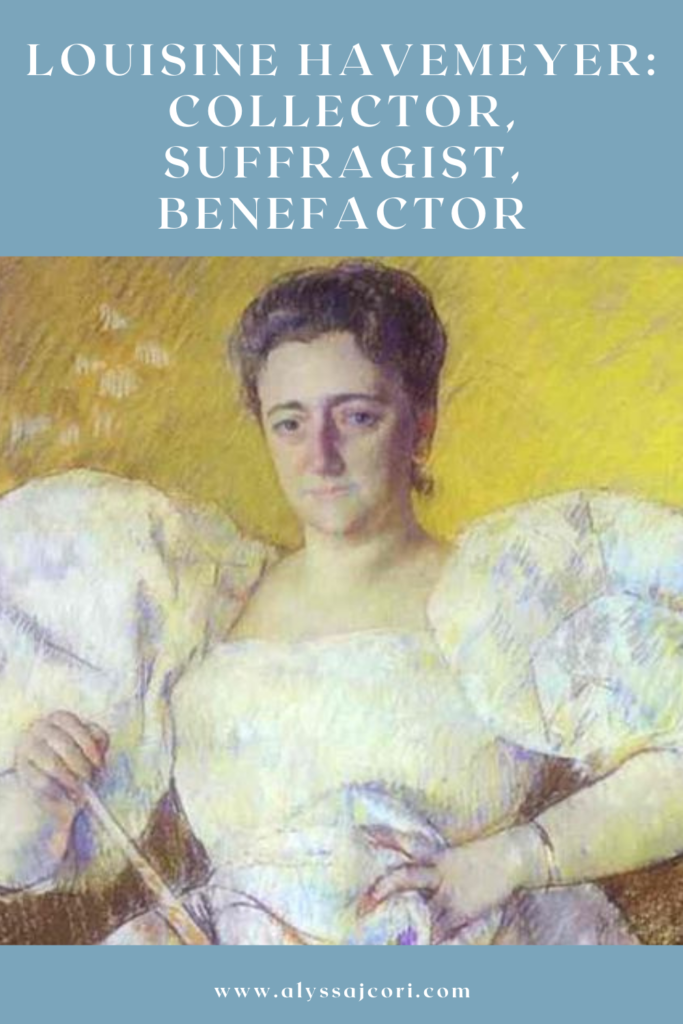Today I am so excited to share the story of a woman whose life’s work contributed substantially to the Metropolitan Museum of Art and to the women’s suffrage movement. In fact, upon her death it was declared that she gave “One of the most magnificent gifts of works of art ever made to a museum by a single individual.” That’s a pretty bold statement. So who was this woman who was a renowned art collector and a friend of Alice Paul? Let’s dive in and meet Louisine Havemeyer!

Early life
Louisine was born Louisine Waldron Elder in New York City in 1855. She lived in the US until 1873 when she set sail for a three year stay in Paris. It was during this time that she was introduced to Mary Cassatt, an American born Impressionist master. It was Cassatt who mentored and encouraged Louisine in her interest in art and helped her make her first purchase at age twenty two, a pastel by Edgar Degas. Not too shabby. This affinity for “modern art” remained with Louisine as she collected throughout her life.
A fortuitous marriage
In 1883 Louisine married Henry Osborne Havemeyer. Interestingly (scandalously?) Henry’s first wife was Louisine’s aunt and the sister of Henry’s brother-in-law. Henry’s first marriage was short lived and ended in divorce, during a time when divorce was not common.

Henry was an entrepreneur who founded the American Sugar Refining Company in 1891. He too was an avid art collector, and the couple was able to amass a diverse and expansive collection during their marriage. Before their marriage I was especially excited to learn that Henry purchased a large quantity of Japanese decorative arts at the Centennial Exhibition in Philadelphia. Check out this post all about that event!
Louisine and Henry had three children (Adaline, Horace, and Electra – what a name!). While all three children also became collectors, Electra founded the Shelburne Museum in Vermont that is made up of different styles of art and architecture.

On the move
In 1901 the Havemeyer’s were on the road (and boat) and went to Madeira, Gibraltar, Algiers and Genoa. Cassatt joined them in Genoa and then they were off to Italy, France, and Spain. They casually got to see works by El Greco and Goya in private collections and purchased two Cézannes in France. What we have to remember is that they were pioneering in their taste for this age. These artists were considered modern and were not yet recognized masters. The Havemeyer’s made decisions on the basis of what they personally liked and advice from those closest to them.

In 1903 they went back to Paris and Italy, and then in 1905 they traveled domestically for business in Colorado, California, and Salt Lake City. Not to be slowed down, the following year they went to Egypt, Greece, Constantinople, Vienna, and Paris.
A darker time
Things weren’t always a joyful sojourn around the globe for Louisine. In 1907 Henry passed away. A few years later, The United States Government brought a suit against Henry’s company for customs fraud. To avoid the press, Louisine, her sister, Anne, and her daughter Electra sailed to Europe in February. Louisine was so distraught by this turn of events in her life that she attempted to commit suicide by throwing herself overboard on the voyage, but Electra stopped her. They pressed on and traveled through Italy, France, and Spain…as one does when escaping the scandal of fraud of your deceased husband’s sugar refining empire. And this did not stop Louisine from continuing to collect.
Supporting the women’s suffrage movement
In addition to collecting masterpieces (with a few record breaking price tags), Louisine began to dedicate her time to supporting the women’s suffrage movement. In 1913 she worked with Alice Paul to found the National Woman’s Party and wrote articles and participated in marches. She was so enthusiastic in fact that she was arrested in 1919 for burning an effigy of President Woodrow Wilson and spent three nights in jail.
She also used her strengths as a collector to contribute to the movement. Louisine organized an exhibition called “Masterpieces by Old and Modern Painters” at M. Knoedler and Co. (an art dealership) to benefit the cause of women’s suffrage. Roughly half of the works in the exhibition were lent by Louisine.
Contributing to the Met
Over the last decade of her life, Louisine planned for her ultimate bequest to the Met. In 1924 she was elected Benefactor of the Met and in 1929 she passed away at the age of 73.

Between the works she bequeathed and the works her children added to the gift, there were over 1,967 objects. The collection and collectors were revered for the range of objects and for their motives to collect. Unlike their contemporaries (like Frick and Morgan), the Havemeyer’s collected for the joy of it rather than for the fame and recognition. This sentiment is demonstrated in a letter to Louisine’s children when she wrote
“I have made very few stipulations in my will in regard to the placing or care of the Collection because I believe there are those who are as intelligent and as interested as I, in the care and conservation of a valuable gift.”
Check out another post about a New Yorker that made great contributions to the Met.
Final thoughts
Louisine was a remarkable woman for her time, or any time! She had a successful marriage and raised a family, supported her husband in his business endeavors, was an exceptional collector and taste maker in the art world, was a force in the women’s suffrage movement, and left behind the most significant gift to the most significant museum in the world.
There is one source I wasn’t able to consult, her autobiography called Sixteen to Sixty: Memoirs of a Collector. It’s available at the New York Public Library, but by the time I wrote this post I had already moved out of the city. I would love to do a follow up on this topic in the future. Let me know if there are any other elements of Louisine’s life you’re interested in learning about!
If you want to learn more about the Havemeyer’s contribution to the Met, check out this free ebook. And you can take a look at this pdf from the Met’s archives that has a comprehensive timeline.
For more history posts, head here.


Leave a Reply